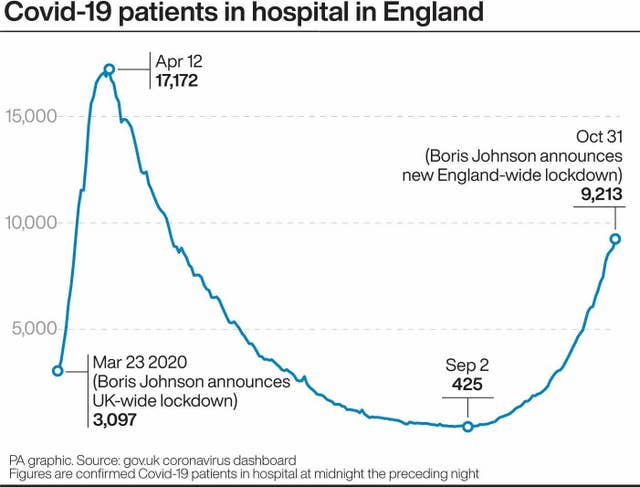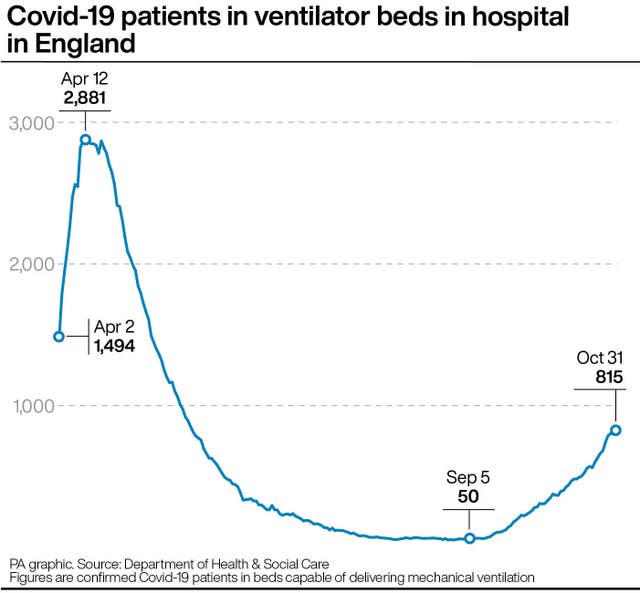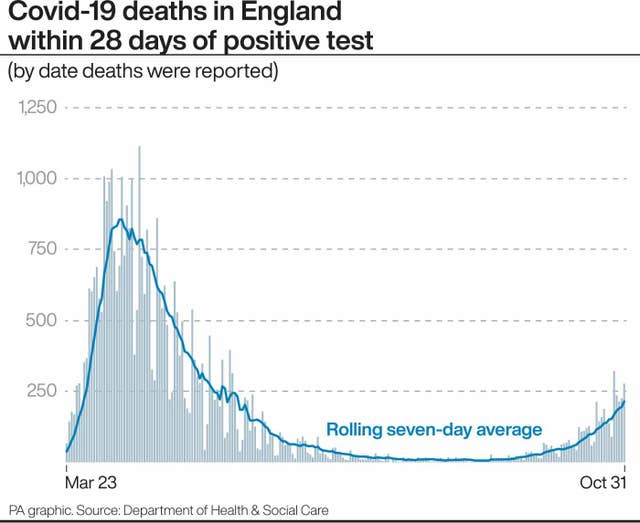How England’s latest Covid numbers compare with the first lockdown
The nationwide data masks some notable regional variations.

England is about to head back into lockdown just over seven months since Boris Johnson announced the first UK-wide Covid-19 restrictions.
How do the latest numbers on hospital admissions, patients in hospital beds and Covid-19 deaths compare with how they looked at the end of March?
Here is what the data shows:
– Hospital admissions
The daily number of hospital admissions in England of patients with Covid-19 has risen sharply in recent weeks, though it remains less than half the total recorded at the peak of the first wave.
Some 1,345 admissions were reported for October 29 – roughly double the number 17 days earlier (664 on October 12).
It’s also the highest daily total since 1,495 were reported on April 21.
On the day Boris Johnson announced the original UK-wide lockdown, March 23, the number stood at 1,128 and then rose rapidly, nearly trebling in the space of nine days to peak at 3,099 on April 1.

The current total is not increasing at the same pace, though the trend for the whole of England masks some notable regional variations.
In north-west England, daily admissions stood at 340 on October 29: the highest number since April 10, though still some way from the first-wave peak of 477 on April 9.
In the Midlands, the number on October 29 was 288: the highest since April 17 (291) but a long way from the first-wave peak of 776 on April 1.
And in south-west England, admissions on October 29 were just 69: under half the first-wave peak of 152 on April 7.
– Patients in hospital
Some 9,213 Covid-19 patients were reported as being in hospitals in England on October 31.
This is the highest number since May 7, and is just over half the number that was reported at the peak of the first wave (17,172 on April 12).
On March 23 the number stood at 3,097 – and it took only a week to treble in size to 9,498 on March 30.
The current number is rising more slowly. It has taken two weeks to roughly double from 4,814 on October 17 to 9,213 on October 31.

In north-west England, the number of hospital patients is now very close to the first wave peak: 2,660 on October 31, compared with a peak of 2,890 on April 13.
By contrast in south-west England, the current number is 431 – around half of the region’s first wave peak of 840 on April 14.
– Patients in ventilator beds
A total of 815 confirmed Covid-19 hospital patients in England were reported as being in mechanical ventilation beds on October 31.
This is the highest number since May 22, but is just over a quarter of the total that was reported at the peak of the first wave (2,881 on April 12).
It has taken nearly three weeks for the total to roughly double from 401 on October 11 to 815 on October 31.

Again, there are notable variations between regions.
In north-west England, the number reported on October 31 was 211 – 60% of the total recorded at the peak of the first wave (350 on April 18).
In south-west England the number currently stands at 40 – around a third of the first-wave peak (126 on April 12).
– Deaths within 28 days of positive test
The Government’s preferred way of calculating Covid-19 deaths is to only count people who have died within 28 days of testing positive for the virus.
By this measure, the number of Covid-19 deaths in England is currently averaging 215 a day, based on a seven-day average of when deaths are being reported.
This is the highest number since the end of May.

On March 23, when Boris Johnson announced the UK-wide lockdown, the number stood at 38.
It then rose sharply, peaking at an average of 857 deaths a day three weeks later.
The latest figures do not yet suggest a similarly rapid increase is under way.
Instead the average has taken two weeks to roughly double from 99 deaths (on October 17) to 215 (October 31).





